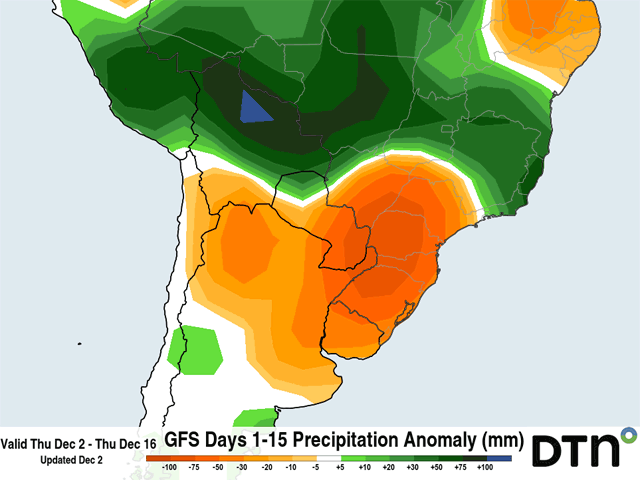South America Calling
Early Corn, Soybeans Drying Out in Southern Brazil
Planting for corn and soybeans got off to a voracious start in Brazil this season. With the threat of La Nina delaying the start of the wet season in central Brazil and the outlook for drier weather overall in southern Brazil, producers got a huge jump on good conditions to the start of the season when they could.
For the most part, the weather cooperated in that endeavor. The threats of La Nina just were not there in the early spring. The wet season started on time and picked up very quickly in October in central Brazil. Showers since then have been very regular and with good intensity, a stark contrast to last year where producers were about a month behind. Over southern states, precipitation was very generous in September and much of October, building up a little soil moisture early enough to convince producers to plant before La Nina dryness took it all away.
Well, November started to turn southern areas back into La Nina mode. The forecast through the end of December shows only small chances for showers in this region. Soil moisture reserves were small to start with and November started to drain them quickly. December then, is going to be especially rough for much of this region. Those early planted corn and soybean crops are getting into their reproductive stages of growth. Most of the crop is in good condition now, but the dryness during the last few weeks has started to take its toll on crop conditions.
Without adequate soil moisture reserves, crops are starting to run out of readily available moisture during the more critical stage in the crop's life cycle.
P[L1] D[0x0] M[300x250] OOP[F] ADUNIT[] T[]
While the forecast for December is not completely devoid of precipitation in most areas, it is close. During the next two weeks, the latest run of the American GFS model has less than 10 millimeters (0.40 inches) for Rio Grande do Sul and up to about 30 mm (1.18 inches) in Parana. Soils in Rio Grande do Sul tend to have more sand in them, and do not have much capacity to hold excess water. So, timely rains are going to be important. That does not look to be the case for the next two weeks, and the last two weeks of the month are not promising either.
But planting in this part of the country is very spread out. Soybeans are still only about two-thirds complete as producers look to more likely rains as La Nina wanes later this summer and the prospects for better rains return to the region.
So, while there will be an effect on a portion of the crop, there is still ample time for rains to return for the rest of the crop.
Central Brazil also looks to continue its streak of good rains. Soil moisture is more than adequate for almost the entire states of Mato Grosso, Goias, and Minas Gerais, and much of Mato Grosso do Sul as well. These areas comprise roughly half of all production of corn and soybeans in the country. The good start to the first-crop corn and soybeans combined with the forecast for continued good weather for the start of their second-crop corn is likely to offset the downturn farther south. The conditions still support record production for both crops of 118 million metric tons (mmt) of corn, and 144 mmt of soybeans from the USDA. Brazil's record for corn came in the 2019-20 season with 102.6 mmt and for soybeans came in the 2020-21 season with 138 mmt.
There is still a lot of season left to go. Early planted corn and soybeans in southern areas are going to find some harsh conditions for the next few weeks. But a lot of the crop in central Brazil should have good conditions and later-planted crops have a chance at some better weather once we get into 2022. So, this month will not have a do-or-die aspect for the total production from Brazil, but it will not be a non-significant impact.
**
Get a full rundown on the 2022 outlook for weather affecting South American crop areas during the DTN Ag Summit, Dec. 5-7, in Chicago. Visit www.dtn.com/agsummit for more details about the summit and to register.
John Baranick can be reached at john.baranick@dtn.com
(c) Copyright 2021 DTN, LLC. All rights reserved.




